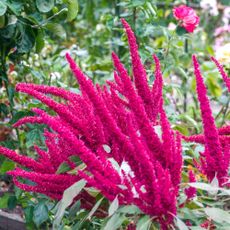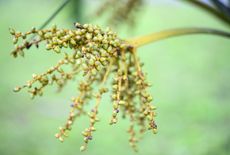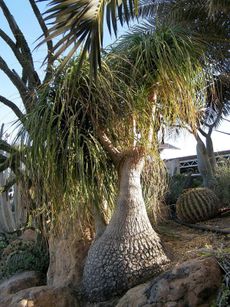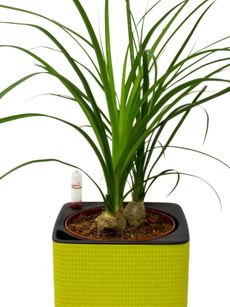Care Instructions For Ponytail Palm - Tips For Growing Ponytail Palms
Ponytail palms area actually succulents, rather than palms. They can live for years in a pot and make excellent houseplants.


Ponytail Palm Quick Facts
Botanical name
Beauarnea recurvata
Height
6 to 8 feet (1.8 to 2.4 m)
Spread
3 to 5 feet (0.9 to 1.5 m)
Sun exposure
Full sun
Soil requirements
Loose, well-drained
Hardiness zones
10 to 11
When to plant
Any time indoors
The ponytail palm is a unique palm tree native to parts of Mexico that can grow very tall in the wild, but that stays reasonably sized as a houseplant. Also known as elephant foot tree or bottle palm, the ponytail plant has a bare, bulbous stem with a tuft of long, narrow leaves at the top that spill over like a ponytail. Its sleek bulb-like trunk and lush, long curly leaves make it visually stunning, and the fact that a ponytail palm is forgiving and easy in its care makes this an ideal houseplant for many people.
Here we are going to cover all elements of indoor ponytail palm care, including light, water, temperature and soil requirements, as well as pruning, propagating, repotting, and overwintering.
Oddly enough, a ponytail palm tree is neither a palm nor a tree. In fact, it is a member of the Agave family and is actually a succulent. It used to be classified as Nolina recurvata, but has since changed to the current and correct Beaucarnea recurvata.
The common characteristics of this plant include a bulbous trunk, which is used to store water, and its long, hair-like leaves that grow from the top of the trunk like a ponytail, giving the plant its renowned name.
Growing Ponytail Palms
Growing ponytail palms in the home is easy. Technically, a ponytail palm tree needs bright light, but because it is such a forgiving plant, it will be okay if you give it bright light about half the time. In fact, if you keep it in low light conditions half the year and provide bright light conditions the other half the year, it will be perfectly happy.
This means that as long as you place a ponytail palm outdoors in the summer, it will tolerate any indoor light conditions you keep it in during the winter. Since this plant is a succulent, it grows best in semi-dry conditions. When growing ponytail palm as a houseplant, you should let the soil dry out significantly in between waterings.
How to Care for a Ponytail Palm
While it can be grown outside as a full-sized tree in the right climate, most people grow ponytail palms as houseplants. Keeping it in a container restricts its size. Indoor care for ponytail palm is minimal, making this a good choice for newbies.
Gardening tips, videos, info and more delivered right to your inbox!
Sign up for the Gardening Know How newsletter today and receive a free download of our most popular eBook "How to Grow Delicious Tomatoes."
Light
As a desert native, ponytail palm needs bright, direct sunlight. Place it in a sunny window, preferably south-facing. You can take it outside in warmer months to get more light.
Water
Water your ponytail palm deeply but infrequently. Let the soil dry out between watering and water even less in winter.
Temperature and Humidity
Ponytail palms do well in standard indoor temperatures. You can allow them to get cooler during winter dormancy. They do not need much humidity and tolerate dry indoor air very well.
Soil
The soil you use should be very light and drain well. Your palm will not tolerate overwatering or excess moisture in the soil. A mix designed for cactuses is a good option.
Fertilizer
Use a cactus or succulent fertilizer once or twice during the growing season.
Problems, Pests & Diseases
Ponytail palms are not particularly susceptible to pests, but like any houseplant might have mealybugs, spider mites, or scale. Root rot is the most common issue for a ponytail palm. Avoid this with good drainage and by not overwatering.
How to Plant a Ponytail Palm
If you need to pot up a new ponytail palm, choose a container with adequate drainage holes. Use a light potting mix, such as those designed for cactuses or succulents. You can pot a palm any time of year if you are growing it indoors, but springtime is best.
Pruning
You don’t have to spend much time pruning a ponytail palm. Remove any dead or dying leaves any time of year to tidy its appearance.
Propagation
There is no easy way to propagate an indoor ponytail palm. Rarely, a plant might produce an offset at the base. If you see a ponytail palm pup, you can snip it off and repot it. It's typical to propagate ponytail palm by seed, but if you're growing it in a container, you're not likely to get ponytail palm flowers or fruit.
Repotting
Ponytail palms make your life easier by being perfectly content in their little containers. You won’t need to repot it very often, maybe every few years. Choose a container that leaves about one inch (2.5 cm). of space between the base of the trunk and the edge of the pot.
Overwintering
For winter, reduce sunlight, water, and temperature. Move the palm to a spot with indirect light, and if possible, let temperatures drop to 55 or 60 degrees Fahrenheit (12.8 to 15.5 Celsius). Water less frequently and let the soil dry thoroughly.
Frequently Asked Questions
Are Ponytail Palms Toxic to Cats or Dogs?
Ponytail palm is a great choice for pet owners because it is not toxic to dogs or cats.
Should I Cut the Brown Tips Off My Ponytail Palm?
You can cut off brown tips on the leaves, but if there is a lot of discoloration, remove the entire leaf.

Mary Ellen Ellis has been gardening for over 20 years. With degrees in Chemistry and Biology, Mary Ellen's specialties are flowers, native plants, and herbs.
- Liz BaesslerSenior Editor
-
 6 Ancient Crops You Should Grow Today – To Boost Health & Sustainability
6 Ancient Crops You Should Grow Today – To Boost Health & SustainabilityWith a history spanning thousands of years, ancient crops have many benefits, being nutrient-dense, packed with flavor, and resistant to climate change.
By Mary Ellen Ellis
-
 Support California Dogface Butterfly: Do More For Zerene Eurydice
Support California Dogface Butterfly: Do More For Zerene EurydiceWould you like to know how to support California’s state insect? We explain the vital pollinating role of the California dogface butterfly and how to help it in your backyard
By Teo Spengler
-
 Propagating Ponytail Palm Seeds – How To Grow Ponytail Palm From Seeds
Propagating Ponytail Palm Seeds – How To Grow Ponytail Palm From SeedsPropagating ponytail palm seeds starts with harvesting fresh seed from the ivory white to creamy green flowers. We'll tell you all you need to know on how to grow ponytail palm from seeds and increase your stock of this wonderful unique plant.
By Bonnie L. Grant
-
 Outdoor Ponytail Palm Care: Can You Plant Ponytail Palms Outside
Outdoor Ponytail Palm Care: Can You Plant Ponytail Palms OutsideGrowing ponytail palm outdoors is possible in warmer climates and caring for ponytail palm outdoors is not difficult. For more information about how to grow a ponytail palm outside, this article will help.
By Teo Spengler
-
 Flowering Ponytail Plants: Does Ponytail Palm Flower
Flowering Ponytail Plants: Does Ponytail Palm FlowerDoes ponytail palm flower? If you are hoping for flowers from this plant, you may have to wait up to 30 years to see it. This article contains additional information about the flowering of ponytail palm trees. Click here for more info.
By Teo Spengler
-
 Can I Replant My Ponytail Palm – How And When To Move Ponytail Palms
Can I Replant My Ponytail Palm – How And When To Move Ponytail PalmsWhen people ask how to transplant a ponytail palm tree, the most important factor is the size of the tree. Transplanting large ponytail palms is a different matter than moving a small one. Read this article to learn about ponytail palm replanting.
By Teo Spengler
-
 Pruning Ponytail Palms: Can You Trim Ponytail Palm Plants
Pruning Ponytail Palms: Can You Trim Ponytail Palm PlantsPonytail palms are truly interesting houseplants with their spiky poof of slender leaves and elephant skin trunk. They are not true palms, however, so can you trim ponytail palms? Read here for the answer on how to prune a ponytail palm.
By Bonnie L. Grant
-
 Ponytail Palm Propagation: Propagating Ponytail Palm Pups
Ponytail Palm Propagation: Propagating Ponytail Palm PupsPonytail palm plants develop pups, or side shoots, as they mature. Propagating ponytail palm pups will give you new little palms. Learn more about removing and planting these pups in this article.
By Bonnie L. Grant
-
 Bonsai Ponytail Palms: How To Prune Ponytail Palm Bonsai
Bonsai Ponytail Palms: How To Prune Ponytail Palm BonsaiThe ponytail palm bonsai tree is great a great low-maintenance option for the bonsai enthusiast or even for those that are new to bonsai plants. Get more information in this article.
By Susan Patterson